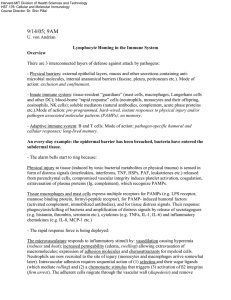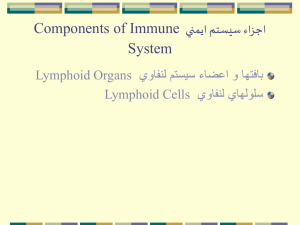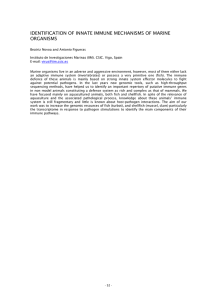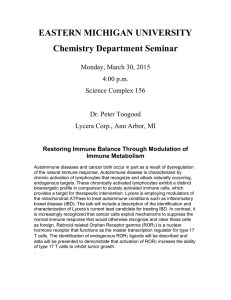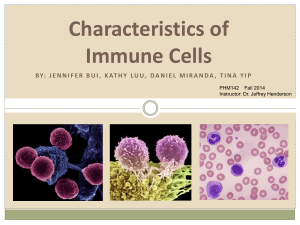Harvard-MIT Division of Health Sciences and Technology
advertisement
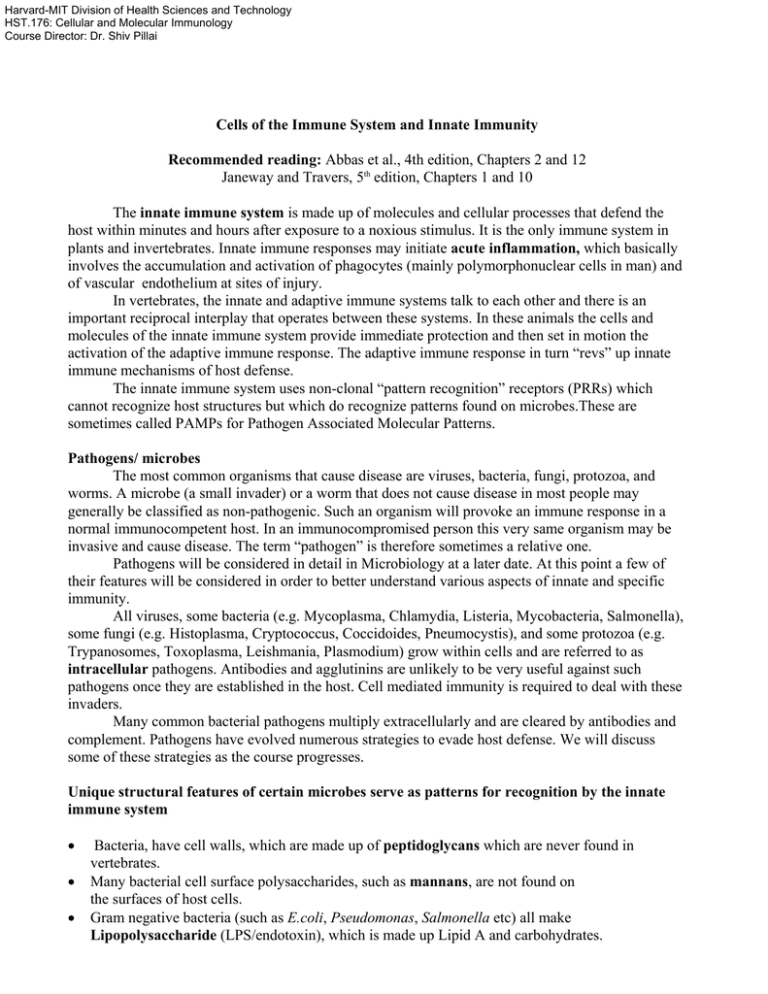
Harvard-MIT Division of Health Sciences and Technology HST.176: Cellular and Molecular Immunology Course Director: Dr. Shiv Pillai Cells of the Immune System and Innate Immunity Recommended reading: Abbas et al., 4th edition, Chapters 2 and 12 Janeway and Travers, 5th edition, Chapters 1 and 10 The innate immune system is made up of molecules and cellular processes that defend the host within minutes and hours after exposure to a noxious stimulus. It is the only immune system in plants and invertebrates. Innate immune responses may initiate acute inflammation, which basically involves the accumulation and activation of phagocytes (mainly polymorphonuclear cells in man) and of vascular endothelium at sites of injury. In vertebrates, the innate and adaptive immune systems talk to each other and there is an important reciprocal interplay that operates between these systems. In these animals the cells and molecules of the innate immune system provide immediate protection and then set in motion the activation of the adaptive immune response. The adaptive immune response in turn “revs” up innate immune mechanisms of host defense. The innate immune system uses non-clonal “pattern recognition” receptors (PRRs) which cannot recognize host structures but which do recognize patterns found on microbes.These are sometimes called PAMPs for Pathogen Associated Molecular Patterns. Pathogens/ microbes The most common organisms that cause disease are viruses, bacteria, fungi, protozoa, and worms. A microbe (a small invader) or a worm that does not cause disease in most people may generally be classified as non-pathogenic. Such an organism will provoke an immune response in a normal immunocompetent host. In an immunocompromised person this very same organism may be invasive and cause disease. The term “pathogen” is therefore sometimes a relative one. Pathogens will be considered in detail in Microbiology at a later date. At this point a few of their features will be considered in order to better understand various aspects of innate and specific immunity. All viruses, some bacteria (e.g. Mycoplasma, Chlamydia, Listeria, Mycobacteria, Salmonella), some fungi (e.g. Histoplasma, Cryptococcus, Coccidoides, Pneumocystis), and some protozoa (e.g. Trypanosomes, Toxoplasma, Leishmania, Plasmodium) grow within cells and are referred to as intracellular pathogens. Antibodies and agglutinins are unlikely to be very useful against such pathogens once they are established in the host. Cell mediated immunity is required to deal with these invaders. Many common bacterial pathogens multiply extracellularly and are cleared by antibodies and complement. Pathogens have evolved numerous strategies to evade host defense. We will discuss some of these strategies as the course progresses. Unique structural features of certain microbes serve as patterns for recognition by the innate immune system • • • Bacteria, have cell walls, which are made up of peptidoglycans which are never found in vertebrates. Many bacterial cell surface polysaccharides, such as mannans, are not found on the surfaces of host cells. Gram negative bacteria (such as E.coli, Pseudomonas, Salmonella etc) all make Lipopolysaccharide (LPS/endotoxin), which is made up Lipid A and carbohydrates. • • • • • Some bacteria contain distinct structures known as teichoic acids and lipoteichoic acids, not found in vertebrate cells. Teichoic acis are phosphate linked polymers of ribitol or glycerol The N-terminal amino acid of most bacterial proteins is formyl-methionine. This is not found in vertebrates except in mitochondria Bacterial lipoproteins (BLPs) contain a unique N-terminal lipo-amino acid, N-acyl Sdiacylglyceryl cysteine. Bacterial DNA contains specific unmethylated CpG repeats that are not found in vertebrate DNA Double stranded RNA produced during viral infections may induce the secretion of Type I inteferons which have anti-viral properties. Cells of the immune system The major phagocytic cells in man are known as macrophages and granulocytes. Macrophages of different sorts exist in tissues and they are derived by the differentiation in tissues of circulating monocytes. Blood cells include erthrocytes (RBCs or red blood cells), leukocytes (WBCs or white blood cells), and thrombocytes (platelets). These cells will be discussed in more detail in Pathology, but are being covered here for completeness. White cells involved in innate immune responses include granulocytes, monocytes/macrophages, and Natural Killer or NK cells (which should be considered a lymphocyte like cell that participates in innate immune responses). On morphological criteria in stained blood films, leukocytes are divided into cells which contain obvious cytoplasmic granules (granulocytes) and those that do not. The latter include lymphocytes and monocytes, and are sometimes collectively called agranulocytes or mononuclear cells. It should be kept in mind that although monocytes and lymphocytes look very much alike in blood smears, monocytes are of myeloid origin. Granulocytes and macrophages are involved in inflammatory responses, and acute inflammation is initiated by these phagocytic cells of the innate immune system. There are three types of granulocytes: neutrophils, basophils, and eosinophils. All these cell types contain distinct cytoplasmic granules, hence their name. Neutrophils or polymorphonuclear leukocytes have multi-lobed nuclei, and two types of cytoplasmic granules. Specific granules are small and numerous, while azurophilic (they stain blue) granules are modified lysosomes. Neutrophils are shortlived cells with a lifespan of 6-7 hours in blood and 1-4 days in tissue sites. They are particularly effective in phagocytosing small particles such as bacteria. Uncoated or opsonized bacteria may be phagocytosed into a vacuole, known as a phagosome. Specific granules fuse with the phagosome. Proton pumps lower the pH and azurophilic granules discharge their contents into the phagosome resulting in the destruction and digestion of microbes. The contents of granules include proteases such as lysozyme, a host of other lysosomal enzymes, and antimicrobial peptides known as defensins. Phagosomes also use inorganic “toxins” such as halide ions, hydrogen peroxide and nitric oxide to kill ingested pathogens. An example of a pattern recognition receptor on neutrophils is the f-Met-Leu-Phe receptor. Eosinophils contain bilobed nuclei and granules which stain red because of the presence of an arginine rich protein in these granules called major basic protein.This protein may contribute to the killing of parasitic worms such as schistosomes. Basophils contain granules that stain metachromatically with basic dyes because of the heparin within these structures. These granules also contain histamine. Basophils participate in immediate type hypersensitivity reactions initiated by allergens bound to IgE. There are non-circulating cells within tissues, which participate in immune responses. These include macrophages, mast cells, interdigitating dendritic cells, follicular dendritic cells, and plasma cells. Macrophages express pattern recognition receptors that can discriminate between self and nonself. These include the mannose receptor and receptors of the Toll family which will be discussed below. Mast cells resemble basophils, and like basophils participate in immediate type hypersensitivity responses. However mast cells and basophils are derived from distinct precursors. There are two types of mast cells, which contain different proteoglycans in their granules. The granules in connective tissue mast cells contain heparin, whereas the granules of mucosal mast cells contain chondroitin sulfate. Interdigitating dendritic cells are commonly called dendritic cells. They are specialized antigen presenting cells which facilitate the presentation of antigen to T lymphocytes. These presentation events occur in secondary lymphoid organs such as lymph nodes. Dendritic cells are often confused, only for semantic reasons, with a different type of cell called a follicular dendritic cell (FDC). FDCs present antigen primarily in the form of immune complexes to B lymphocytes. Plasma cells are end cells of the B lymphocyte lineage and function as antibody secreting factories. They will be discussed in the lecture on B lymphocytes. While innate immunity is primarily the realm of phagocytic cells such as granulocytes and macrophages, NK cells also primarily participate in innate immunity. These cells are a type of lymphocyte distinct from B and T lymphocytes. They possess receptors that recognize cells in a state of “stress” which express a specific MHC like molecule after infection or trauma. They also possess receptors which recognize antibody coated particles and can be activated to lyse and kill pathogens when so triggered. Table I: CELLS THAT MEDIATE INNATE IMMUNE RESPONSES CELLS OF MYELOID ORIGIN 1. MACROPHAGES (DERIVED FROM MONOCYTES) 2. GRANULOCYTES NEUTROPHILS ( aka POLYMORPHONUCLEAR LEUKOCYTES) EOSINOPHILS BASOPHILS 3. MAST CELLS 4. DENDRITIC CELLS (Activate the adaptive immune system) CELLS OF LYMPHOID ORIGIN 1. NATURAL KILLER (NK) CELLS "DUAL FUNCTION" LYMPHOCYTES 2. γδ T CELLS 3. B-1 B CELLS We have already considered B and T lymphocytes in a general way. These lymphocytes have clonal receptors and can recognize an extraordinary range of distinct shapes. While lymphocytes are, by and large, components of the adaptive immune system, we will consider later in the course how, once lymphocytes are activated, they can enhance the function of the innate immune system. However, quite apart from the interplay between the innate and adaptive immune systems, subsets of B and T lymphocytes have evolved to enhance the diversity of the innate immune system. B-1 B cells, and marginal zone B cells are involved in the production of “natural antibodies” that are capable of recognizing a wide range of naturally occurring microbial structures. γδT cells may represent an ancient T lymphocyte lineage which has evolved to deal with cells that have been infected or which are in a state of stress. Humoral and extracellular mechanisms involved in Innate Immunity Epithelial surfaces offer immediate protection from invaders. Apart from the epithelial barrier itself, mucus and antimicrobial peptides provide an initial level of protection. If pathogens do penetrate these barriers, humoral mechanisms for disposing of pathogens include secreted lectins and the complement system. Defensins are antimicrobial peptides that are secreted by Paneth cells in intestinal crypts and are also found in neutrophil granules. Mannose binding lectin (MBL) is a major agglutinin in the serum. MBL is a member of the collectin family, and structurally resembles C1q, the first component of complement. When MBL is bound to mannose or N-Acetyl glucosamine on target pathogens it associates with two protease known as MASPs and can activate the complement system. MBL-MASP complexes can cleave the C3, C4 and C2 components of complement. Proteolytically cleaved complement components may be covalently attached to pathogen surfaces and eventually nucleate the formation of a pore complex which inserts itself in the pathogen membrane and facilitates the lysis of the microbial target. The reason why complement components do not form holes in host membranes is the presence of inhibitory molecules on vertebrate surfaces. Apart from the “lectin” pathway, there are two other major ways in which the complement cascade may be activated. Some bacterial surfaces may directly activate the complement cascade converting quiescent proteases into active molecules. This process of activation is known as the “alternate pathway” for historic reasons, although it is an evolutionarily older way by which complement is activated compared to the “classical” pathway. In vertebrates, immune complexes between antigen and antibody can bind C1q and activate the complement cascade via the “classical” pathway. Activation of phagocytes destroys parasites, initiates inflammation, and facilitates the activation of adaptive immunity Ingestion of pathogens by phagocytes activates signal transduction for two broad reasons. The first is to contain and destroy the pathogen. The second is to mount a response which will not only be of greater specificity but will also protect the individual from future invasions by this pathogen’s close relatives. Molecular processes which contribute to the death and the disposal of the pathogen within that particular phagocyte may be activated. Pathogen containment may involve sending signals for reinforcements, and increasing vascular permeability to facilitate the arrival of the new troops. Potent chemoattractants include N-formyl methionine containing bacterial peptides and the cleaved complement component C5a. Activated phagocytes secrete a chemoattractant known as IL-8. This “containment” response, which may generate local warmth, swelling, redness, and pain is referred to as inflammation. The driving force for inflammation is the release by activated phagocytic cells of cytokines such as IL-1 and TNF. IL-1 is an example of a “pro-inflammatory” cytokine. It can induce the secretion of IL-6 which is sometimes considered an “effector” cytokine. IL-8, mentioned above, is an example of a chemoattractant cytokine or a “chemokine”. In addition to the disposal of pathogens, signaling by activated phagocytes may contribute to the ability of the phagocyte to activate T lymphocytes and induce an adaptive immune response. Dendritic cells are not phagocytic but they are particularly effective in activating T cells. A critical component of this activation event is the induction of expression of cell surface proteins known as costimulatory ligands or costimulatory molecules. B7.1 and B7.2 are costimulatory molecules which are absolutely required for T cell activation. Macrophages may be induced, particularly by certain intracellular pathogens, to secrete a cytokine known as IL-12. IL-12 may contribute to the activation a subset of helper T cells that can in turn further activate macrophages. Costim ulatory ligands Cytokines and chem okines PH AGO CYTE A CTIV ATIO N 1. INCREA SED KILLING A BILITY 2. SECRETIO N O F CYTO KINES A ND CH EM O KIN ES 3. EXPRESSION O F CO STIM ULA TO RY LIGA N DS The Interplay between Innate and Adaptive Immunity- the action begins in secondary lymphoid organs Injury or infection first activates the innate immune system. It would be ideal if the specific immune system only got triggered by antigens that are components of pathogens but which are not part of innocuous structures (such as food particles) that we may be exposed to. This requirement for an infectious or injurious context for the activation of the adaptive immune system has been referred to as the “danger” hypothesis. It is closely connected to another central hypothesis in immunology known as the “two-signal” hypothesis. The coating of antigens by complement components can dramatically influence the ability of B cells to be triggered. We will discuss how this happens in more detail in the lecture on B cell activation. T cell activation requires two signals. The first signal (SIGNAL ONE) is delivered by the T cell receptor which recognizes antigens bound to MHC molecules. The second signal (SIGNAL TWO) is delivered by costimulatory receptors which respond to costimulatory ligands on antigen presenting cells. If the host does not sense “danger” – i.e. pattern recognition receptors are NOT activated, costimulatory ligands such as B7.1 and B7.2 are not expressed and T cells cannot be activated. When microbes induce the expression of costimulatory ligands, T cells are activated and an adaptive immune response ensues. Clearly this is an important mechanism for discriminating between self and non-self. Lymphocyte activation occurs primarily in lymph nodes and other secondary lymphoid organs such as the spleen and Peyer’s patches. All the players involved in adaptive immune responses, B lymphocytes, T lymphocytes, dendritic cells, (and antigen) make their way to lymph nodes – this is where the action is – this is where DANGER can be sensed! Naïve lymphocytes keep frequenting lymph nodes – in search of partners and looking out for DANGER that will drive the very specific and supercharged liaisons with other lymphocytes and dendritic cells which will give their lives meaning. Lymphocytes that get turned on really know how to party! Naïve lymphocytes move from node to node looking for action. Activated lymphocytes on the other hand are committed creatures – they are directed away from the nodal discotheques that they previously frequented but home in on infected tissues to deal with the source of the Danger that got the action started. A very ancient molecular pathway is turned on both in activated phagocytes that are about to dispose of a pesky pathogen as well as in the more sophisticated and modern danger-sensing cell of the immune system – the interdigitating dendritic cell. .Both phagocytes and dendritic cells respond to signals via Toll like receptors. In phagocytes these receptors may largely contribute to the activation of pathways which lead to phagocyte activation and pathogen elimination. Similar molecular pathways that are turned on in dendritic cells may permit these cells to present antigen more effectively. Toll Like Receptors (TLRs) activate phagocytes and DCs Over 500 million years ago a signaling pathway evolved in invertebrates that was used both during development as well as to activate phagocytes. A cell surface receptor known as Toll, regulates ventral polarization of the Drosophila embryo. Downstream of Toll is a fly NF B homolog called Dorsal. NF B is a transcription factor that resides in the cytosol complexed with a specific inhibitor called I B. The intracellular domain of the Toll protein contains a domain which is now referred to as the Toll-Interleukin-1 Receptor or TIR domain. Once activated, Toll and Toll Like Receptors signal through a couple of sequentially activated adaptor proteins to eventually activate a kinase that phosphorylates I B. Phosphorylated I B is targeted for ubiquitination and proteasomal degradation. Once freed from its shackles NF B moves into the nucleus and activates the transcription of target genes which in cells of the inn ate immune system may orchestrate the activation of phagocytes or the expression of costimulatory ligands which are interpreters of DANGER. There are 10 vertebrate Toll Like Receptors of TLRs. TLR4 is the best studied and is the receptor for bacterial lipopolysaccharides or endotoxin. TLR2 recognizes peptidoglycans and bacterial lipoproteins. TLR5 recognizes flagellin. TLR9 is the receptor for CpG DNA. It is likely that the remaining TLRs will also prove to be PRRs that recognize specific PAMPs. Recommended Reading: Janeway and Travers, 5th Edition, Chapters 1 and 9. Additional Readings: Fearon D.T. and Locksley, R.M. (1996) The instructive role of innate immunity in the acquired immune response. Science 1996, 272, 50-54. Medzhitov, R., and Janeway, C.A. (1998) An ancient system of host defense. Current Opinion in Immunology 10: 12-15. GETTING YOUR BEARINGS At this point you should have a broad feel for blood cells and innate immunity. Inflammation will be discussed in more detail in Pathology. The complement system will be discussed again when considering antibody dependent protection mechanisms. You should have an idea as to how the innate immune system and the adaptive immune system work together. Some “basic concepts” about adaptive immunity are summarized below. BASIC “CONCEPTS” IN ADAPTIVE/SPECIFIC IMMUNITY Most of the “concepts” required to understand adaptive immunity are listed below. They may take a few weeks to be fully appreciated, and are certainly not written in stone, but return to these “rules” whenever you have a doubt about the big picture! 1. Lymphocytes are generated in central/primary lymphoid organs. B cells develop in the bone marrow and T cells in the thymus. It is here that immune diversity is generated and the foundation for self non-self recognition is laid. clones. 2. Lymphocytes that have receptors that recognize self structures avidly are eliminated or rendered quiescent in central organs during a “developmental window”. All developing lymphocytes in young and old animals must pass through this temporally defined window and “run the gauntlet” of avid selfrecognition. 3. Naive lymphocytes leave the central organs, are capable of recirculation, and home to peripheral lymphoid organs (lymph nodes, Peyer’s patches, and spleen), but NOT to tissue sites. They hop from one lymph node to the next, seeking to connect with cognate foreign antigens and specific lymphocytes that they might enter into a dance with. 4. Naïve lymphocytes are activated in secondary/peripheral lymphoid organs if they sense the presence of “danger”. Danger is interpreted primarily by dendritic cells that home to lymph nodes after encountering antigen. 5. Activated lymphocytes do NOT home to secondary lymphoid organs but are targeted to tissue sites where the source of antigen will be dealt with. 6. An activated lymphocyte may become an effector cell which may be short-lived or long-lived, or it may be immortalized as a long-lived memory cell. Glossary for Lecture II: Alternative pathway: a complement activation pathway that is triggered by microbial surfaces and does not involve antibody. Basophils: a type of granulocyte which is involved in immediate type hypersensitivity responses Chemokine: Chemoattractant cytokine; a small secreted protein which activates G-protein coupled serpentine receptors which, among other things, may affect the chemotaxis of immune cells. Classical pathway: complement activation pathway that is triggered by antigen-antibody complexes. Costimulatory ligands: Proteins expressed on antigen presenting cells which provide a “second signal” for lymphocyte activation Cytokines: Secreted or sometimes membrane bound biological response modifiers. Dendritic cell: Professional antigen presenting cell that presents antigen to T cells Eosinophils: a type of granulocyte that may contribute to the elimination of certain parasites. Follicular Dendritic Cell (FDC): cell found in lymphoid follicles involved in triggering B cells. Not the same as a dendritic cell. Lectin pathway: complement activation pathway induced by MBL bound to target mannans. Mannose Binding Lectin: C1q like protein of the collectin family which can opsonize certain carbohydrate antigens and also fix complement by the lectin pathway. NFκB A dimeric transcription factor which may be held in the cytoplasm in a complex with a specific inhibitor, IκB. Neutrophil (aka polymorphonuclear leukocyte): A major type of granulocyte which is a major player in innate immunity and acute inflammation. Pattern recognition receptors: Receptors that recognize broad patterens on non-self antigens. Toll Like Receptors: Vertebrate Receptors of the Drosophila Toll Family which initiate signaling for innate immunity (and for development).

